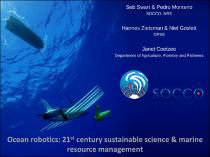JavaScript is disabled for your browser. Some features of this site may not work without it.
- ResearchSpace
- →
- Research Publications/Outputs
- →
- Conference Publications
- →
- View Item
| dc.contributor.author |
Swart, S

|
|
| dc.contributor.author |
Monteiro, Pedro MS

|
|
| dc.contributor.author |
Zietsman, H

|
|
| dc.contributor.author |
Goslett, Daniel G

|
|
| dc.contributor.author |
Coetzee, J

|
|
| dc.date.accessioned | 2016-03-04T11:32:32Z | |
| dc.date.available | 2016-03-04T11:32:32Z | |
| dc.date.issued | 2015-10 | |
| dc.identifier.citation | Swart, S, Monteiro, P, Zietsman, H, Goslett, NG and Coetzee, J. 2015. Ocean robotics: 21st century sustainable science & marine resource management. The 5th CSIR conference, Ideas that work, CSIR ICC, Pretoria, South Africa, 8- 9 October 2015 | en_US |
| dc.identifier.uri | http://conference.csir.co.za/speakers/ | |
| dc.identifier.uri | http://hdl.handle.net/10204/8443 | |
| dc.description | The 5th CSIR conference, Ideas that work, CSIR ICC, Pretoria, South Africa, 8- 9 October 2015 | en_US |
| dc.description.abstract | South Africa’s exclusive economic zone (EEZ) covers over 1.5 million km2 and comprises the remote waters around the Prince Edward Islands in the Southern Ocean. The benefits of an EEZ come with the responsibility of managing its resources, one of which is commercial fish stocks. These are currently assessed via acoustic surveys using manned survey vessels, which are extremely expensive to undertake. The CSIR’s autonomous ocean robotics are able to venture in remote oceans for months at a time – unmanned – while transmitting data in real-time via satellite communications. The fisheries acoustic and environmental data being collected on a more continuous basis and over larger spatial domains by the CSIR’s gliders are shown to be of comparable quality to that collected by ship. The gliders can dramatically improve the temporal and spatial coverage of fish stock assessments, which will allow for fisheries managers to set quotas that improve yields and reduce the probability of overfishing. The enhanced observational capabilities enable scientists to monitor the response of fish stocks to environmental variability and climate change that is already being seen to drive long-term change in our fish stocks. | en_US |
| dc.language.iso | en | en_US |
| dc.publisher | CSIR | en_US |
| dc.relation.ispartofseries | Workflow;00000 | |
| dc.subject | Fisheries acoustics | en_US |
| dc.subject | Glider | en_US |
| dc.subject | Marine resource management | en_US |
| dc.subject | Ocean robotics | en_US |
| dc.subject | Southern Ocean Seasonal Cycle Experiment | en_US |
| dc.subject | SOSCE | en_US |
| dc.subject | Wave glider | en_US |
| dc.title | Ocean robotics: 21st century sustainable science & marine resource management | en_US |
| dc.type | Conference Presentation | en_US |
| dc.identifier.apacitation | Swart, S., Monteiro, P. M., Zietsman, H., Goslett, N., & Coetzee, J. (2015). Ocean robotics: 21st century sustainable science & marine resource management. CSIR. http://hdl.handle.net/10204/8443 | en_ZA |
| dc.identifier.chicagocitation | Swart, S, Pedro MS Monteiro, H Zietsman, NG Goslett, and J Coetzee. "Ocean robotics: 21st century sustainable science & marine resource management." (2015): http://hdl.handle.net/10204/8443 | en_ZA |
| dc.identifier.vancouvercitation | Swart S, Monteiro PM, Zietsman H, Goslett N, Coetzee J, Ocean robotics: 21st century sustainable science & marine resource management; CSIR; 2015. http://hdl.handle.net/10204/8443 . | en_ZA |
| dc.identifier.ris | TY - Conference Presentation AU - Swart, S AU - Monteiro, Pedro MS AU - Zietsman, H AU - Goslett, NG AU - Coetzee, J AB - South Africa’s exclusive economic zone (EEZ) covers over 1.5 million km2 and comprises the remote waters around the Prince Edward Islands in the Southern Ocean. The benefits of an EEZ come with the responsibility of managing its resources, one of which is commercial fish stocks. These are currently assessed via acoustic surveys using manned survey vessels, which are extremely expensive to undertake. The CSIR’s autonomous ocean robotics are able to venture in remote oceans for months at a time – unmanned – while transmitting data in real-time via satellite communications. The fisheries acoustic and environmental data being collected on a more continuous basis and over larger spatial domains by the CSIR’s gliders are shown to be of comparable quality to that collected by ship. The gliders can dramatically improve the temporal and spatial coverage of fish stock assessments, which will allow for fisheries managers to set quotas that improve yields and reduce the probability of overfishing. The enhanced observational capabilities enable scientists to monitor the response of fish stocks to environmental variability and climate change that is already being seen to drive long-term change in our fish stocks. DA - 2015-10 DB - ResearchSpace DP - CSIR KW - Fisheries acoustics KW - Glider KW - Marine resource management KW - Ocean robotics KW - Southern Ocean Seasonal Cycle Experiment KW - SOSCE KW - Wave glider LK - https://researchspace.csir.co.za PY - 2015 T1 - Ocean robotics: 21st century sustainable science & marine resource management TI - Ocean robotics: 21st century sustainable science & marine resource management UR - http://hdl.handle.net/10204/8443 ER - | en_ZA |






